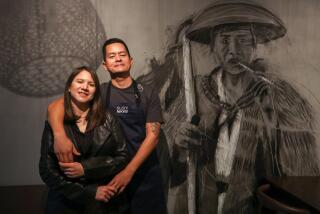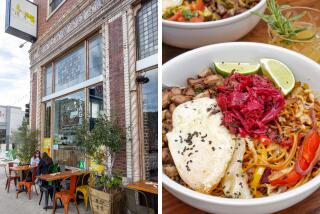U.S. Grazing Subsidies Aid Japanese-Owned Ranches : Trade: Grower in Montana cashes in on quota’s end. Firm finds bull market back home for fatter, tastier beef.
- Share via
DILLON, Mont. — Here in the Old West, the Japanese are reinventing the cow.
On a panoramic livestock spread in the Rockies, a Japanese meat company is making an abrupt U-turn away from the trend toward a leaner low-cost cow in quest of one that offers a tastier, juicier and much higher quality cut of beef for the refined Japanese palate.
Last month, Japan lifted quotas on U.S. beef imports. Now, less than 100 miles from Yellowstone in a sage and scrub-tree valley explored by Lewis and Clark in 1804, the Tokyo-based Zenchiku Co. is moving to take advantage of this new trade opportunity and set the pace for the what could be the first bull market in U.S.-raised beef in a generation.
In short, with trade barriers coming down, the Japanese are positioning themselves in America to be their own trading partner. And they are doing it with the help of Uncle Sam.
Here in the mile-high Rockies where snow falls late into the spring, Zenchiku holds deed to 28,000 acres under its Lazy 8 brand and leases another 41,000 acres of U.S. taxpayer-subsidized federal rangeland. And here, with a mix of old leather chaps and new computer chips, amid meadow muffins and a Zen rock garden, where ranch hands have names like Jim and Kazuhiru, the cow is being methodically re-engineered with the same determined spirit that the Japanese brought to the remaking of the automobile.
This month, Japanese-bred beef are being displayed for the first time to Japanese consumers with the label “Made in Montana.”
But it will not be beef that many American consumers would recognize. It is much more heavily marbled with muscular fat, like the savory steaks that may live deep in your memory from decades past.
It is beef raised slowly on quality grain feeds to give it flavor and old-fashioned texture--unlike U.S. beef, which is typically nourished on the cheapest feed, including plant waste and growth-inducing hormones, without discriminating concern for the resulting subtleties in taste or texture.
The Lazy 8 beef is otherwise pampered with the kind of care almost unheard of these days in domestic cattle circles as the Japanese ranchers take aim on their home market and its more demanding tastes. Just as in Japanese cars, Zenchiku has started with the goal of putting “quality” back in the cow.
The resulting brand-name beef will sell for many times the price of generic U.S. supermarket meat.
Some U.S. taxpayers are sure to be confounded to learn the Japanese are such spirited businessmen that they not only are positioning themselves in the vanguard to capitalize on this fastest growing market for beef exports--the Japanese island itself--but they are doing it with the help of below-cost and controversial U.S. government rangeland leases justified partly as a way to preserve an American way of life, the cowboy life.
On the other hand, American steak lovers may end up in Zenchiku’s debt for having challenged virtually every convention of the hidebound American beef business, and demonstrating that the cow is not just a chewy run-of-the-million commodity but an elegant delicacy with mouth-watering potential.
“I have listened ad nauseam to people like Lee Iacocca say that we (Americans) can produce a product that’s as high quality as the Japanese. Then the first thing they do is begin by using the media to try and convince people to buy their product. It doesn’t work. . . . It’s a K mart mentality. . . . We want to produce the quality first,” says John W. Morse Jr., the 30-year veteran cattleman who runs the Zenchiku spread.
Morse, the only non-Japanese officer of the $1.6-billion Zenchiku meat producing firm, served as an agricultural trade adviser to Presidents Jimmy Carter and Ronald Reagan. He was influential in getting the Japanese to liberalize beef imports in the first place.
These days, he rules a barony 10 miles from Dillon that is Japan’s largest and best known ranch in the United States. Reportedly, there are four or five others operating more quietly.
This ranch with its Lazy 8 brand was purchased three years ago at a reported cost of $12.3 million. To the eye, it appears different from other huge spreads in this part of Montana only in the occasional tour bus of Japanese executives who come bouncing up the dirt road to visit and the two apprentice cowhands from company headquarters in Tokyo, and the slippers outside the main ranch house for those who leave their boots at the door.
Like other ranches in the region, Zenchiku’s operation provides winter range for its 6,000-plus head of cattle on its own private property but moves them onto federal rangeland in the summers. The company purchased these valuable U.S. Bureau of Land Management leases, and leases on 9,000 acres of state land, along with its private property when it moved into Montana nearly three years ago.
The ranch has been open to publicity, unlike some other Japanese-owned properties. And this has resulted in several upbeat stories about the cultural novelty of the Japanese adjusting to the wide-open West and the ranch’s plans for exporting beef to Japan.
Morse said, however, that no one has raised a question about a Japanese corporation buying and utilizing rights to U.S.-taxpayer subsidized public rangeland.
“We don’t think it’s subsidized, we think we pay our way. And we strongly resent the implications,” Morse said. “We very carefully thought it out. We are good stewards of the public lands. I don’t think it’s an issue. . . . And we are not the first to do it.”
Under Bureau of Land Management leases, Zenchiku and other ranches pay the standard fee of $1.97 per cow per month for grazing on public lands. There is no competitive bid on these lands in the west, and the leases are bought and sold just like any commodity. In conversation, Morse describes the ranch as 77,000 acres in size, not differentiating between private and public deeds.
Even by the BLM’s own calculations, the standard fee does not cover the cost of government range management programs. Taxpayers make up the difference, and they also typically pay half of livestock developments, including water troughs and fences. Leases on Montana state land are subject to competitive bidding and cost more than twice as much as charged by the BLM. Leases to graze on private lands are even more expensive.
Critics of the range program, such as U.S. Rep. Mike Synar (D-Okla.), believe the government is squandering millions of dollars by not charging more for rangeland. He is seeking a rate increase to $8.70 per cow per month.
A source in Washington said a forthcoming Government Accounting Office report has found range fees too low by more than $100 million nationwide.
“This is supposed to help small, family-owned businesses,” says Synar. “But only 2% of ranchers in this country enjoy this unique status. And of them, 10% control 95% of the grazing land. Now we have Zenchiku, and we’re not only subsidizing a giant corporation but a foreign corporation that is out to compete against farmers and ranchers who don’t enjoy access to public lands.”
Citizenship has been an issue in grazing for more than a half-century. Individuals who hold grazing permits must, by law, be citizens. Under the 1934 law that governs grazing, the BLM has said corporations which hold permits do not have to be U.S.-owned. A separate agency, the U.S. Forest Service, however, requires corporations to be 80% U.S.-owned to graze on public lands it administers.
Without taking sides, Interior Secretary Manuel Lujan Jr. believes “Congress needs to determine” if allotment of grazing permits to foreign corporations “was the actual intent of the law,” says spokesman Steven Goldstein.
“It’s doubtful Congress foresaw in 1934 that foreign corporations would be using grazing lands. Times have changed,” says Goldstein.
The BLM says it has no way of knowing the extent of grazing permits held by foreign corporations. But the Montana Stockgrowers Assn. said it is a “very small part” of the cattle business in this state.
Morse said Zenchiku would not object to a “reasonable” increase in grazing fees. In fact, he blames the livestock industry’s obsession with producing beef at the lowest possible cost for simultaneously reducing its quality so much that it is unappetizing to the huge Japanese market.
“We’re not price driven. We’re market driven,” says Morse.
Concern about fat in the diet is blamed for the decline in consumption of beef domestically and has driven U.S. cattlemen to try to manufacture the leanest possible cow. But the corresponding loss of muscular fat is one of the reasons that the taste of prime cuts of beef also has declined.
“People buy these low-fat hamburgers and never mind that they smear mayonnaise on them or a piece of cheese, they think it is healthier and better,” Morse says, shaking his head.
The Japanese answer the matter of health and taste differently. Their diets typically have much less red meat, but when they do eat beef they prefer a higher quality with more fat--and they are willing to pay astronomical prices for the very best. The famous Kobe beef of Japan, which can be almost white due to 80% muscular fat, commands prices of up to $100 a pound.
Zenchiku does not raise beef in that league, at least yet. But in just three years, through genetic selection and feed experiments, it has begun breeding cattle that contain up to 40% muscular fat--meat that is lavishly marbled with fat and hugely appealing to the gourmet palate. By contrast, modern U.S. beef commonly contains only 5% to 10% muscular fat.
More than muscular fat, though, the Japanese grade beef as to color--prefering a pure blood red to anything darker or lighter and they insist on fat that is pure white rather than yellowish. Beyond this, Zenchiku is experimenting with which combination of grains produces the richest and tangiest flavors.
Lazy 8 cows are fed special and experimental diets at feedlots in Malta, Ida.; Oberlin, Kan., and Gonzales, Calif. But it has not been easy introducing feedlot managers to the Japanese way.
“In America, feed is energy. I don’t care what feedlot you pick, if you ask the manager what produces the best meat they look at you like you’re crazy. They can tell you what’s the cheapest and most efficient to produce the lowest acceptable quality. But not what gives you the best meat,” says Morse.
“There has been very little research on diet’s effect on quality. We’re trying to learn that,” he adds.
American cattlemen generally bring a beef steer to its market weight of about 1,100 pounds as fast as possible using growth-inducing hormones. There are grading penalties for beef that is too old. Lazy 8 beef is fed more slowly and without hormones in the belief that the texture is preserved that way. And its cattle are allowed to mature to about 1,500 pounds.
Packaging and grading is supervised by ranch personnel at a packing house in Los Angeles, and Lazy 8 beef goes across the ocean in cargo ships inside specialized refrigerated containers. Freezing is not allowed because it reduces quality.
“We want to produce the best quality beef in America . . . our first issue is quality. Price is next,” says Morse. He contrasts this with the philosophy of the U.S. beef industry. “Slowly but surely beef (in America) has been relegated to the status of a commodity rather than a product: price is might.”
That mentality, however, seems to be changing, even if only a little. This year the Lazy 8 will sign its first contracts with other U.S. cattlemen to produce beef to Zenchiku’s standards. That is, a local rancher will be given the genetic stock and then agree to raise the cattle on a diet and under the conditions that Zenchiku specifies. All this beef is destined for the Japanese market.
But after that, who knows?
Morse said his ranch already has received inquiries from top-line steak houses, which have a difficult time finding the highest-grade beef. “We may attempt to serve that market. The discerning U.S. public would still like to have a quality steak, I think.”
Times researcher Doug Conner in Seattle contributed to this story.
BACKGROUND
Japan lifted import quotas on foreign beef effective April 1, but the duty remains high. This year, a 70% duty is imposed on imported beef, including its base value and the cost of shipping it to Japan. That means a side of beef that reaches the wholesaler in the United States at about $2.05 a pound costs $5.05 a pound in Japan. Commissions and distribution and retail markup add to the consumer price. Next year, the duty drops to 60%, and to 50% in 1993. In international trade talks under way in Geneva, the Japanese are resisting any further liberalization of beef imports.
More to Read
Inside the business of entertainment
The Wide Shot brings you news, analysis and insights on everything from streaming wars to production — and what it all means for the future.
You may occasionally receive promotional content from the Los Angeles Times.










